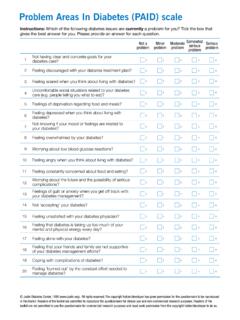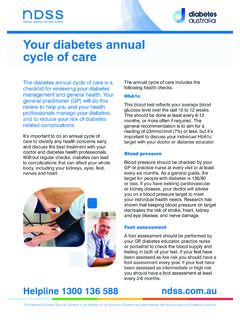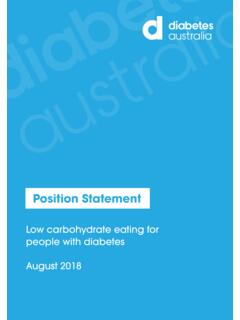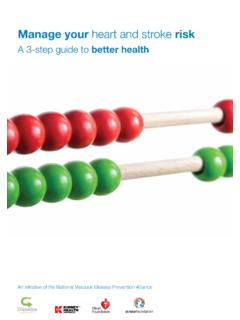Transcription of Diabetes-related complications
1 1300 136 588 The National diabetes Services Scheme is an initiative of the Australian Government administered with the assistance of diabetes complications Looking after your diabetes is important for your long-term health. diabetes is a condition which, over time, may cause damage to the body s organs, blood vessels and nerves. If your diabetes is well managed and you take care of your general health, you can reduce the risk of Diabetes-related complications . What are the most common complications of diabetes ? Diabetes-related complications can include damage to: the large blood vessels (macrovascular/cardiovascular complications ), leading to heart attack, stroke or circulation problems in the lower limbs the small blood vessels (microvascular complications ), causing problems in the eyes, kidneys, feet and nerves other parts of the body, including the skin, teeth and blood vesselsThe main cause of large blood vessel damage in people with diabetes is atherosclerosis.
2 Atherosclerosis occurs when plaque made up of cholesterol and other fats builds up inside the walls of blood vessels. This causes narrowing of the vessels, reducing the blood flow to organs and other parts of the body. If the plaque ruptures, this can form a blood clot which can totally block the blood supply to organs and other parts of the body. This can affect the blood vessels that supply blood to the heart, brain and lower limbs. 2 of 4 Diabetes-related complications Lower limbs A reduced blood flow to the lower limbs can affect your legs and feet.
3 This is called peripheral arterial disease. This can cause pain, cold and discoloured lower legs and feet, slow healing wounds, shiny skin on the legs, and pain when walking. The long-term lack of blood flow to the lower limbs can increase the risk of risk of damage to the large blood vessels is higher if you: have blood glucose levels above your target range have high blood pressure have high levels of cholesterol or triglycerides in the blood are above the healthy weight range or carry extra weight around your waist are a smoker have a family history of heart doctor can check your risk for large blood vessel damage during your annual cycle of blood vessels Long periods of high blood glucose levels can cause damage to the small blood vessels in the eyes, kidneys and nerves.
4 Eyes Over time, the small blood vessels in the retina can become damaged and leak fluid or bleed. This is called retinopathy. Other eye conditions such as cataracts and glaucoma are more common in people with diabetes . Eye conditions can be managed more successfully if they are found and treated Reduced blood flow increases the risk of having a heart attack. Heart attack occurs when the blood supply to one of the blood vessels in the heart is suddenly blocked, causing damage to the heart muscle. Symptoms of a heart attack can include severe central chest pain which may move up the neck or down the left arm and difficulty in breathing.
5 Some people with diabetes may not have any symptoms of a heart attack due to nerve Reduced blood flow increases the risk of having a stroke. A stroke can occur when the blood supply to one of the blood vessels leading to the brain is suddenly blocked. Symptoms of a stroke can include weakness or numbness down one side of the body, a droopiness on one side of the face, or difficulty talking. 3 of 4 Diabetes-related complications Other parts of the bodyTeeth and gums There is a higher risk of dental problems when blood glucose levels are above the target range for a long period of time.
6 If you smoke, this also increases the risk. Dental problems can include tooth decay, gum infections (gingivitis) and gum disease. Tooth and gum infections can increase your risk of heart disease. Signs of dental problems include a dry mouth and sore, swollen or bleeding gums. It s important to brush your teeth twice a day and floss daily to prevent dental problems. Regular visits to your dentist will also help maintain oral health. Skin There is a higher risk of skin problems when blood glucose levels are above the target range.
7 Skin problems can include very dry skin, caused by damage to the small blood vessels and nerves. There is also a higher risk of skin infections. You can protect your skin by avoiding irritants such as hot baths and showers, scented soap and household cleaning products. Use moisturisers daily to avoid dry skin, but not between your toes. Treat any cuts on your skin promptly to prevent infection. See your doctor if you have any skin problems. Have your eyes checked by an optometrist or ophthalmologist (eye specialist) at least every two years to look for early signs of damage.
8 Early detection and treatment of eye problems provides the best High blood pressure and high blood glucose levels can damage the small blood vessels in the kidneys. As a result, the tiny blood vessels that filter the blood become leaky, and the kidneys don t work as well as they should. This is called diabetic nephropathy or diabetic kidney disease. Have your kidneys checked at least once every 12 months by your doctor. This will involve a urine test and a blood test as part of your annual cycle of care. Early detection and treatment of kidney problems provides the best Nerve damage can be caused by high blood glucose levels, drinking large amounts of alcohol, and other disorders.
9 Damage can occur to the nerves, in the legs, arms and hands. This is called peripheral neuropathy. Damage to nerves can cause pain, tingling or numbness. There can also be damage to the nerves affecting your stomach (gastroparesis), intestines (diarrhoea or constipation), bladder, or genitals (erectile dysfunction in men). This is called autonomic NDSS and youThis factsheet is intended as a guide only. It should not replace individual medical advice and if you have any concerns about your health or further questions, you should contact your health June 2016 The NDSS provides a range of services to help you manage your diabetes .
10 These include our Infoline and website for advice on diabetes management, NDSS products and a range of support programs to help you learn more about managing your diabetes . 4 of 4 Diabetes-related complications Make healthy food choices from a wide variety of foods, such as wholegrains, fruit, vegetables, lean meats, fish and low-fat dairy foods. It s also important to limit foods high in saturated fat and salt (sodium). A dietitian can help you make the best food choices. Do regular physical activity, as this is a great way to reduce your blood pressure.











